Black garlic does look like it has just survived a house fire, but it has been a key ingredient in Asia and Korea for a long time as a culinary staple and a health supplement. It has twice the antioxidants of raw garlic and has a lovely unique balsamic sweet-savory taste. But what exactly is black garlic, and how can you make it at home?
So, let’s see why these burnt-looking bulbs are all the rage among nutritionists and the culinary industry.
In this article, I will cover everything you need to know about this highly-prised ingredient and how you can easily make black garlic it at home using your slow cooker.
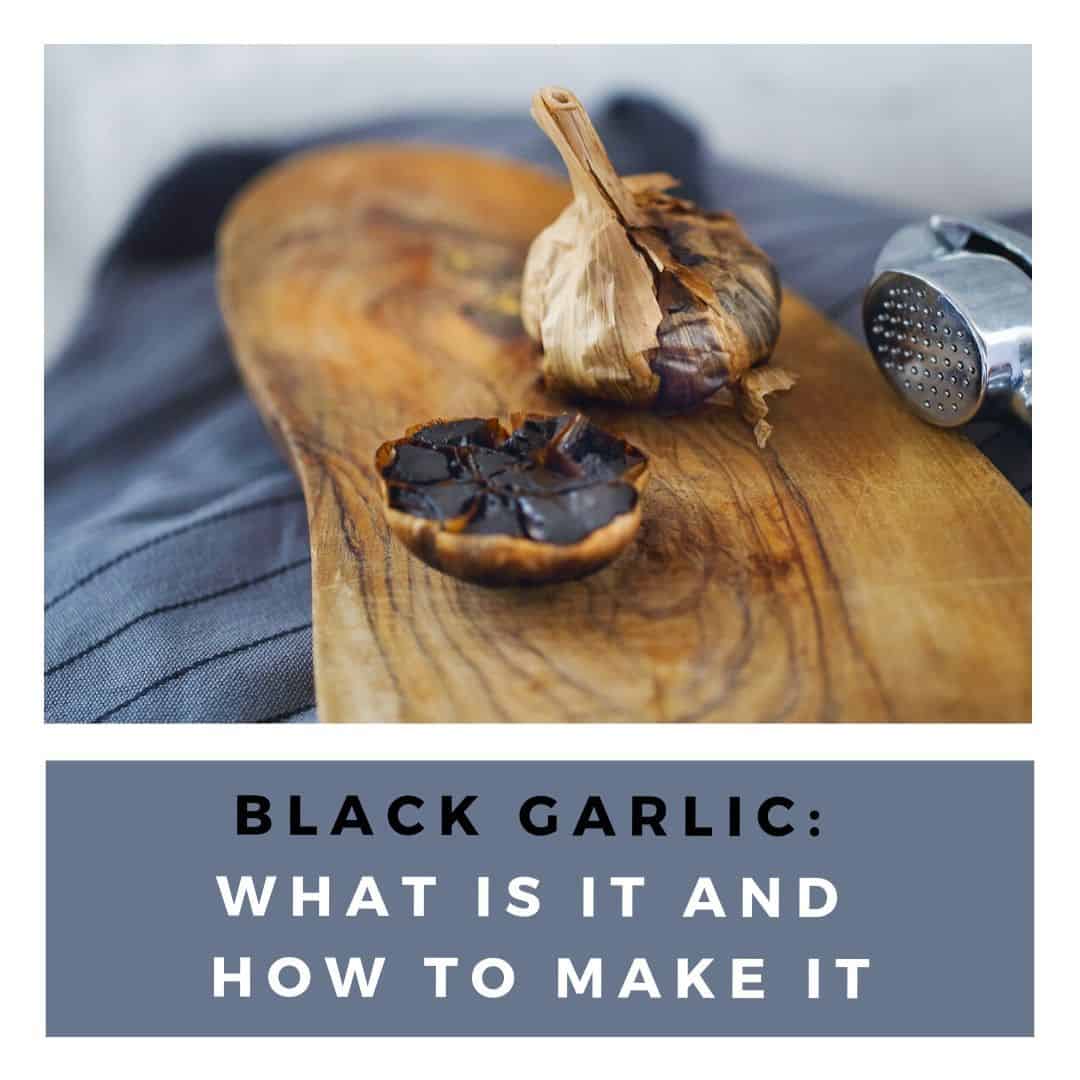
This aged garlic is rather popular among many chefs due to its sweeter and gentler flavor compared to raw white garlic.
In recent times, there has been a surge of interest and curiosity surrounding black garlic due to its numerous benefits. Produced from standard culinary garlic (allium sativum), black garlic (allium nigrum) is believed to provide many of the same advantages as raw garlic, ranging from preserving cognitive function to safeguarding heart health and much more.
It has a distinct texture, taste, aroma, and elevated concentration of antioxidants. It has a delicious, milder, sweeter flavor and is more versatile compared to a clove of regular raw garlic.
Overall, black garlic offers a tasty and potentially beneficial alternative to raw garlic.
How Is Black Garlic Made?
Black garlic is made from fermented bulbs of raw fresh culinary garlic in a humidity-controlled environment.
Black garlic is prepared by allowing regular garlic to ferment in temperatures ranging anywhere from 120-160 degrees Fahrenheit (50-70 degrees in Celsius) for three to five weeks.
During this time period, it goes through a chemical process called the Maillard reaction, which occurs between amino acids and reducing sugars. [1]
The fermentation process changes the tone of garlic and renders a very distinct flavor, aroma, and texture. Most importantly, this process is believed to enhance the wholesome nutritional value of garlic. [2]
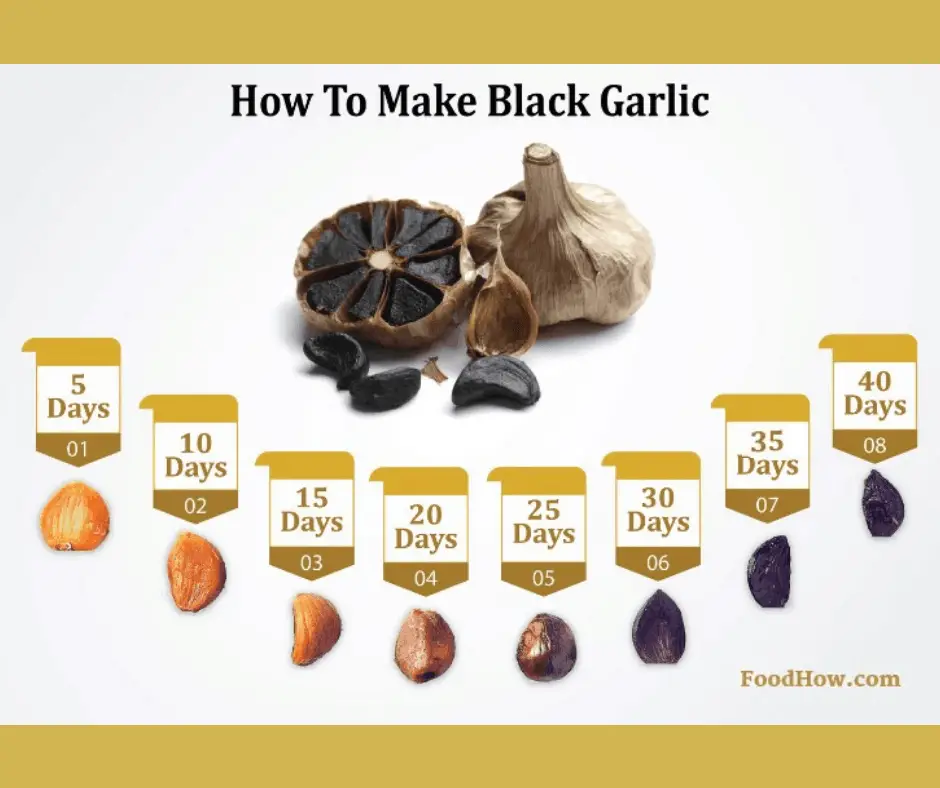
What Makes It Better Than Regular Garlic?
Besides the fact that black garlic is a tasty ingredient, it has many amazing health benefits. It is packed with antioxidants like fresh garlic but is much more powerful as the fermentation doubles its antioxidants.

Black garlic has almost double the content of allicin than regular garlic and has a higher content of antioxidants, and is rich in amino acids.
The key bioactive component of regular garlic is allicin. [3] However, black garlic does not contain allicin. It has enzymes called alliin and alliinase. Allicin is released only when garlic is crushed or chopped. This compound is responsible for the spicy and pungent aroma of fresh garlic.
Allicin is an unstable compound and breaks down within minutes. When regular garlic is fermented, allicin converts into S-allyl-cysteine (SAC). This compound is responsible for its antioxidant, anti-inflammatory properties.
The actual nutritional content depends on the fermentation process. It has been shown that some key nutritional components, such as flavonoids and polyphenol, are increased during the long aging process.
To view a detailed nutritional value comparison for black garlic vs. raw one, check out the Department of Agriculture Food Products Database here and here.
According to Taoism, black garlic has been given the reputation of granting immortality and compared to regular garlic. It has double the amount of antioxidants, and it is also a great source of digestive enzymes.
What Are The Benefits Of Black Garlic?
It is a storehouse of nutrients and is considered a superfood. It is claimed to offer a wide range of benefits.
Some of them include:
- Provides Antioxidants
- Boosts Heart Health
- Reduces Inflammation
- Relief From Allergy
- Protects Cognitive Function
- Stabilizes Blood Sugar
- Kicks Up Your Immunity
- Provides Vitamins

1. Has a Lot Of Antioxidants
It is loaded with antioxidants. Antioxidants play an important role in maintaining health and well-being. They help fight free radicals to prevent oxidative stress and cell damage. Antioxidants are also known to reduce the risk of developing some chronic conditions.
2. Could Improve Heart Health
In a recent study, the clinical effects of BG were explored; it was found that both regular and black garlic had a positive effect on heart health and were effective in reducing damage to the heart by improving circulating antioxidant levels. [4]
Studies have also shown that BC can lower triglycerides and cholesterol levels, thereby reducing the risk of heart disease.
A study conducted at Penn State University has shown that S-Allyl cysteine from garlic inhibited cholesterol synthesis. [5]
3. May Reduce Inflammation
Research has revealed that fermented garlic contains as many as 100 bioactive compounds. One of the most popular anti-inflammatory agents S-allyl cysteine is found in black garlic. Due to the high concentration of these compounds, black garlic is known to be highly potent in reducing inflammation. [6]
4. Relief From Allergy
Another study has shown that black garlic may deter allergy and inflammation-causing genes. However, the study was conducted on animals, so we cannot say with certainty that it will have the same effect on humans as well. [7]
5. May Preserve Brain Health
It could have a positive effect on cognitive health. It is rich in antioxidants and can reduce inflammation, so it may help in the prevention of cognitive conditions such as Parkinson’s disease and Alzheimer’s disease.
A study conducted on rats has revealed that aged garlic could improve memory and reduce inflammation of the brain. Another study has shown that black garlic can protect against oxidative stress and prevent memory impairment. [8]
6. Could Stabilize Blood Sugar
Adding it to your diet may help maintain healthy blood sugar levels. This could prevent diabetes and other chronic illnesses that stem from high blood glucose levels. Research has indicated that black garlic extract may be effective in lowering triglycerides and blood cholesterol, and blood sugar levels as well.
Another study has shown that levels of antioxidants in it can prevent diabetes-related complications.
7. Boosts Immunity
The immune system helps prevent illness, infections, and even chronic conditions. Its high antioxidant levels could enhance immunity by reducing inflammation, fighting free radicals, and preventing oxidative damage. In fact, compared to regular garlic, it exhibits stronger antioxidant and anticancer properties and is more powerful in boosting immunity. [9], [10]
8. Provides Vitamins
Scientists have conducted studies to assess the effect of the curing process on vitamin levels. It was found that heat used to convert regular garlic into fermented garlic helps concentrate the vitamins. The total water-soluble vitamin content is 1.15-1.92 times higher compared to regular garlic.
How Much Black Garlic To Eat A Day?
I see the most often recommended dosage range of black garlic is about 500-1,300mg a day, divided into 3 servings. The minimum dose that is considered effective is one medium-size clove consumed 2-3 times a day.
Considering the delicious sweet and syrupy taste of it, it is not hard to meet the required dosage, and it won’t even give you bad breath.
Where To Buy It?

Aged garlic is not just more appealing and palatable than the regular one, but it also offers a host of additional health benefits. So, it makes sense to include it in your daily diet.
You probably can not find black garlic in most supermarkets near you, but you can certainly find some online.
Check out these two of my favorite ones below that I have been getting from Amazon.
TAP ON IMAGE TO VIEW PRICE
TAP ON IMAGE TO VIEW PRICE
However, it can be quite expensive to buy ready-made black garlic; although the cost of regular garlic is quite cheap, then the cost of black garlic is so much higher, mainly due to its time-consuming fermentation process.
But don’t worry, you don’t need to buy these expensive bulbs from the health food shop; keep reading as I will show how you can make it at home using some simple kitchen appliances.
Making Your Own Black Garlic In A Slow Cooker Or A Rice Cooker
All right, so you want all the health benefits of this tasty ingredient – but how, exactly, do you make it?
There are a couple of easy ways to make it at home, using some common kitchen appliances that almost everyone already has – either a rice cooker or a slow cooker! In fact, with just a few steps and some patience, you can have black garlic that tastes fresher than any kind you can find in a store.
IMPORTANT! When making black garlic in a slow cooker, it’s important to use a model that has a manual ‘warm‘ setting. Slow cookers with only ‘low‘ and ‘high‘ settings won’t work for this purpose because they won’t provide the low temperatures needed to ferment the garlic slowly. In fact, using ‘LOW’ settings on a regular slow cooker will end up cooking the garlic instead of fermenting it.
Additionally, automatic warm settings can’t be relied upon to maintain a consistent low temperature throughout the entire fermentation process. So be sure to use a slow cooker with a manual warm setting to get the best results for your black garlic.
If you don’t have a manual slow cooker with a warm setting, then check out the one below, which is perfect for the job and also comes with a rubber lid strap to really help you to minimize the garlic smell.
TAP ON IMAGE TO VIEW PRICE
Note: The ideal temperature range for making black garlic in a slow cooker is between 120-160°F (50-70°C). This temperature range allows the garlic to ferment slowly over a period of 4-6 weeks, resulting in the desired texture, flavor, and health benefits. It’s important to ensure that your slow cooker can maintain a consistent temperature within this range throughout the entire fermentation process.
Watch this short video below for simple steps on how to make it using a rice cooker.
Step One: Decide how many bulbs you want to make. Then choose the right size slow cooker or rice cooker for the project.
Step Two: Make sure your bulbs are very dry. Place a few sheets of kitchen towel or a small bamboo table mat or a piece of foil at the bottom and then place the bulbs in a single layer in your slow cooker or rice cooker and turn on the lowest possible setting, which should be a ‘Warm’ setting and not ‘Low’ setting.

Note: Do not peel or separate the cloves; leave the garlic bulbs whole.
To maximize the amount of garlic you can cook at once, consider using a cooking or steaming rack like the one below. This will allow you to add multiple layers of garlic to your slow cooker without having to stack them on top of each other, resulting in more evenly fermented black garlic.
TAP ON IMAGE TO VIEW PRICE
Note: It’s important to note that as the fermentation process begins, the smell of the garlic will become very strong within a few days. It is advisable to place the slow cooker in an area that is out of the way because it will need to be plugged in for 3-4 weeks.
Step Three: Set your rice or a slow cooker on the lowest heat setting; it MUST BE the warm setting. With a rice cooker, DO NOT press the cook rice button. You only want the ‘Warm’ setting.
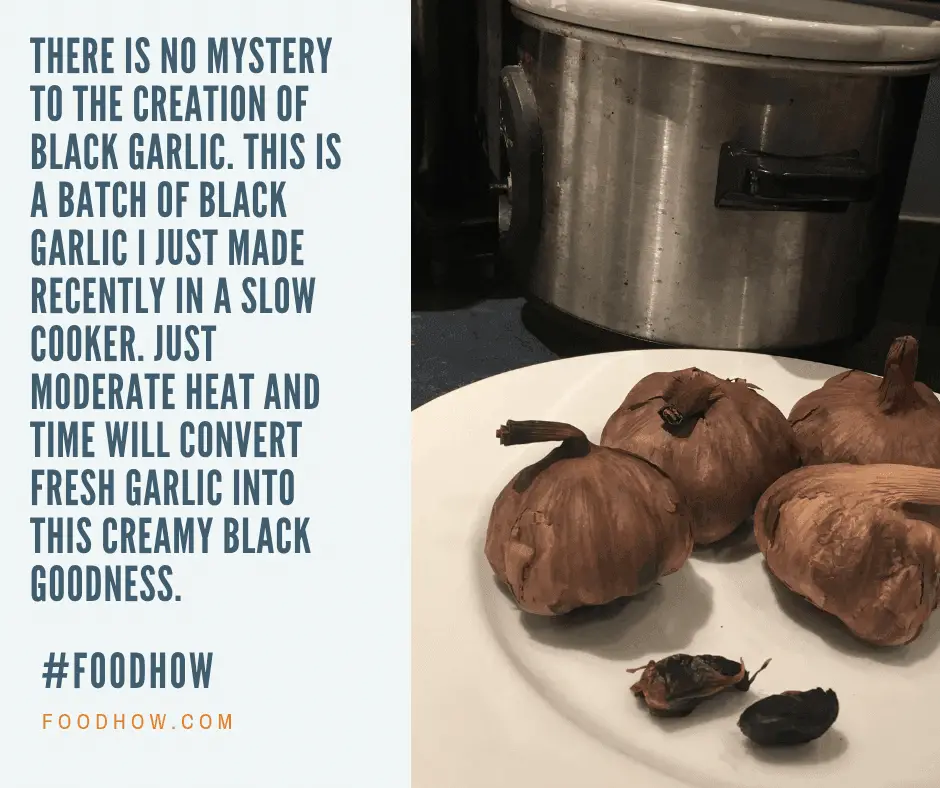
The process of making black garlic is easy, but it takes a bit of patience to achieve that final result.
Step Four: WAIT. That’s it. Just wait. It isn’t an exact science, but most people find that three weeks is a good amount of time to wait. And while you wait, no peeking every day to see how it is doing. For the lovely caramelization to happen, you need to leave it sealed inside the canister of your cooker.

But while waiting, still keep an eye on your appliance to make sure the power is on, and it is on the right heat setting.
So, no checking it for the first 15-20 days – just mark it with the date, and after about 20 days, you can carefully remove one bulb to check if it has fermented enough.
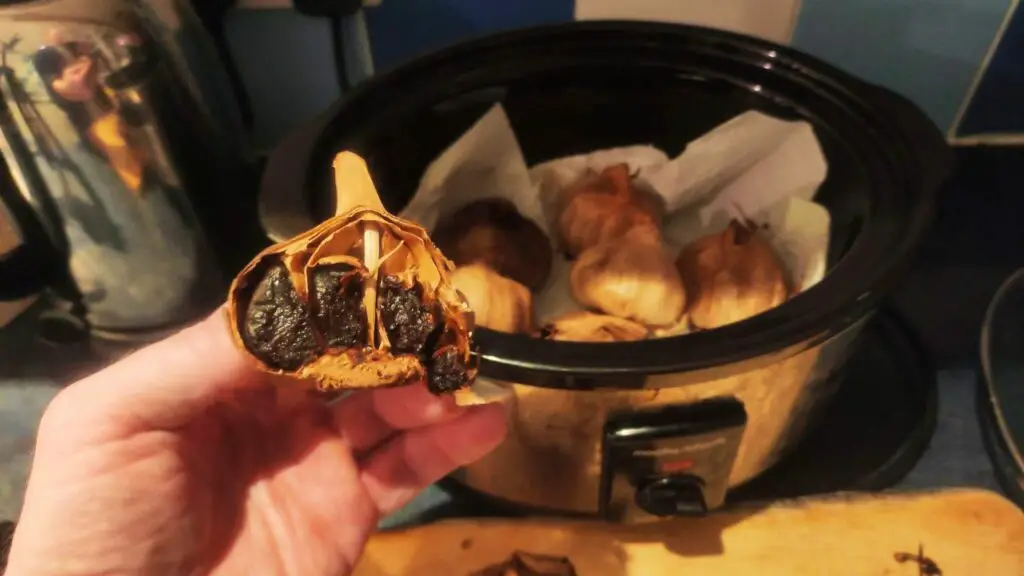
It should be black or very dark brown in color. If it is light brown, place it back in the pot and leave it there for another 10 to 15 days before checking again. Then, it should be ready for you to enjoy this delicious sticky goodness!
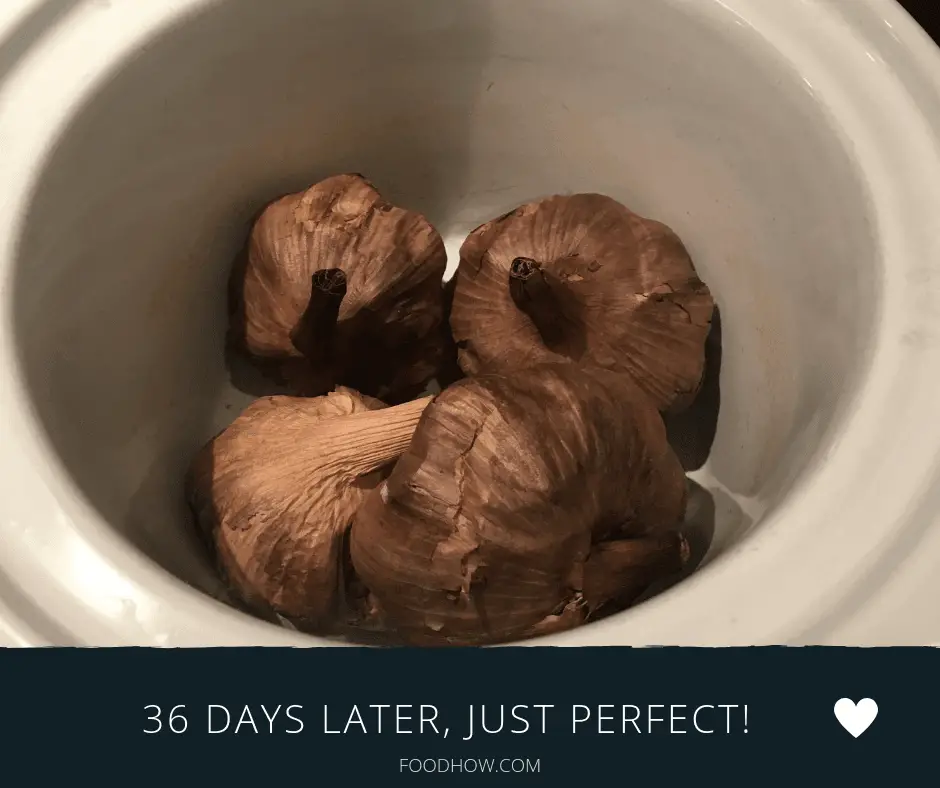
I usually use my fermenter, but I made this patch just to show how easy it is to make it just using a regular crockpot.
How To Use A Garlic Fermenter And Is It Better Than A Slow Cooker?
TAP ON IMAGE TO VIEW PRICE
Suppose you’d rather not leave your crockpot running for 4-6 weeks, or the smell becomes unbearable. In that case, you can use a home black garlic fermenter like the one below that is equipped with a professional heating and humidity system to ensure it won’t try out during the fermentation process.
TAP ON IMAGE TO VIEW PRICE
Watch this video below to learn how the garlic fermenters work.
I do a lot of DIY projects, and one thing I’ve learned the hard way is that sometimes I waste a lot of money trying to DIY something that I could’ve made just fine with the right tools. Having the right tool for the job, in this case, means having Full Automatic Intelligent Control Fermenter.
Unlike your rice or slow cooker, this one is made to be left on for weeks, and so is ultimately safer. It also produces black garlic slightly quicker, which is a huge bonus!
Check out this popular fermenter below that is equipped with a professional humidity and heating system. This garlic fermenter is very easy to use and gives you a very healthy, tasty, and preservative-free product without making your house smell.
TAP ON IMAGE TO VIEW PRICE
Black Garlic Shelf Life
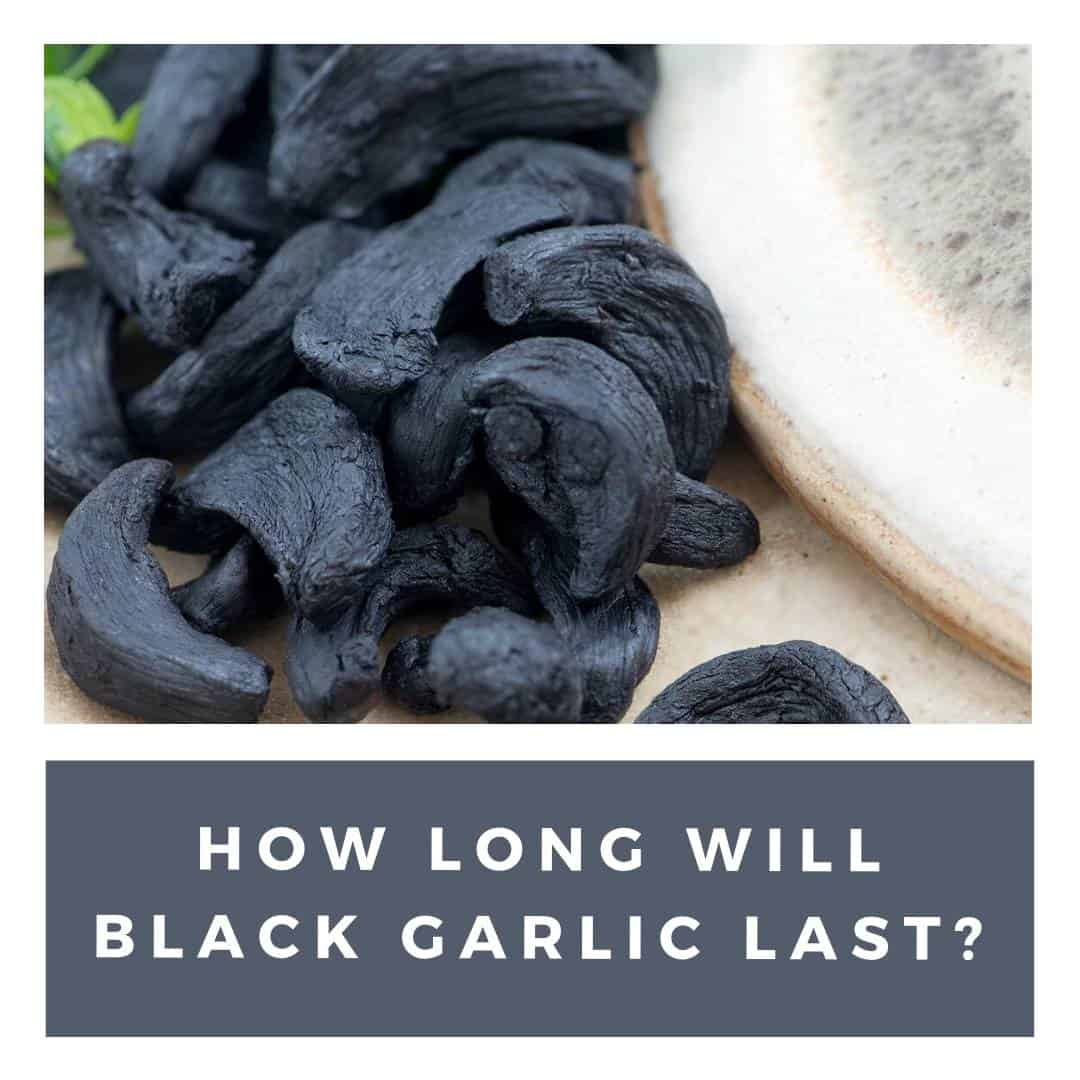
Like with many fermented foods, black garlic is hard to spoil, and therefore it has quite a long shelf life. Most manufacturers give it the best before the date of 4-5 months and used by, or the expiration date can be up to 6 months. However, from personal experience, I have noticed that if stored correctly, it is still edible even after six months.
The shelf life above can also be applied to homemade bulbs.
Best Way To Store Black Garlic
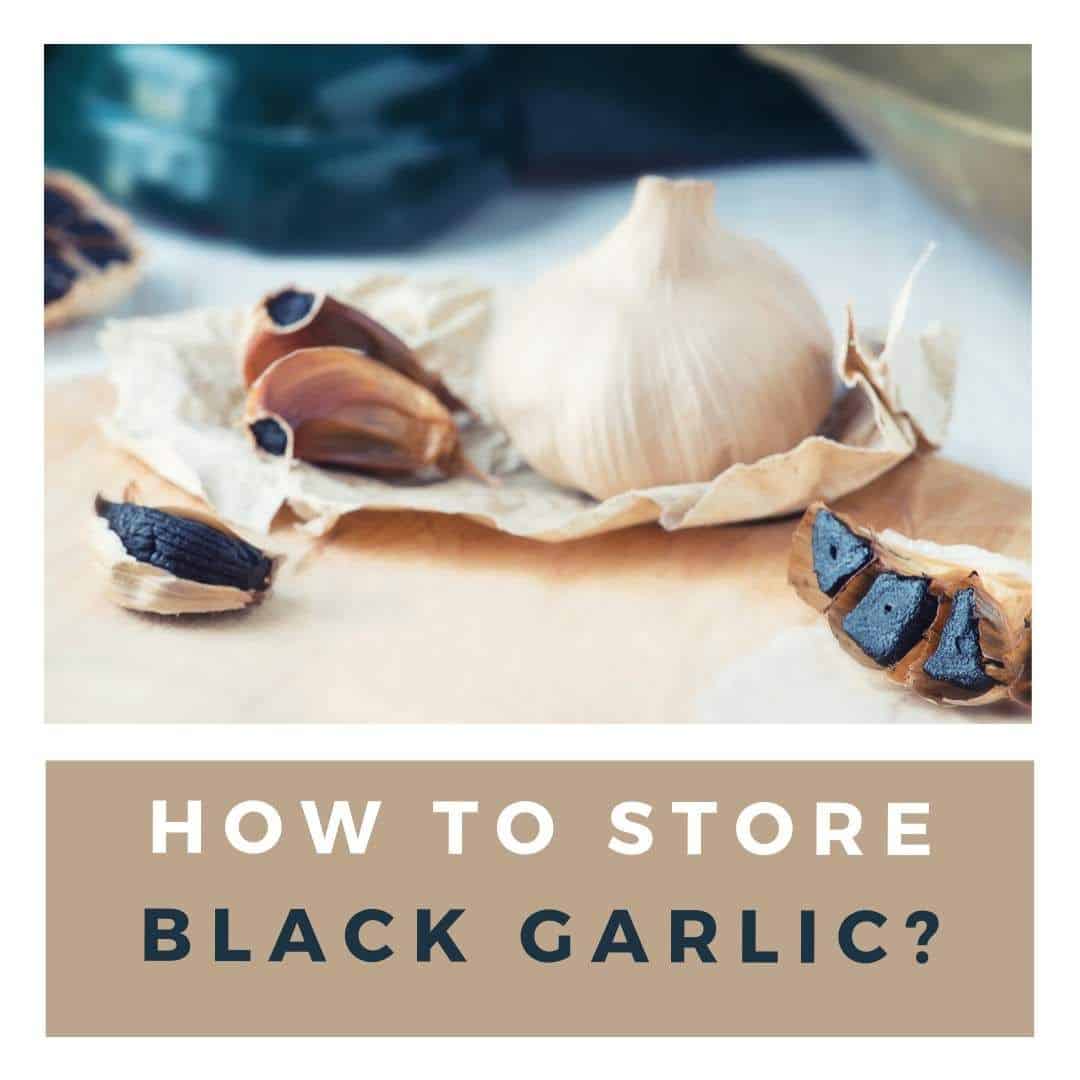
If eaten within a month, you can keep black garlic in the kitchen cupboard at room temperature. The general recommendation that you may find on most product labels is to store it in a cool and dry place. It can also be stored in the fridge, but it is not necessary.
Also, storing it for the long term, some people recommend freezing it. Although it should work in theory, I have not personally tried it, so I don’t know what sort of texture they will have after defrosting them.
To store homemade black garlic. You can keep it in a basket, jar, or container, or you can use a paper bag. Make sure it has access to some fresh air. Put some paper towels on the bottom to keep the garlic dry to prevent any molding. Also, do not stack it high or squish the bulbs tightly together. Make sure they have room to breathe.
How To Tell If Black Garlic Has Gone Bad?
To establish if your black garlic is still good to eat, look for the usual suspects. Make sure that it has no mold, unpleasant or strange smell, or peculiar coloring. If any of these things are present, it is best to throw away the entire bulb rather than checking it clove by clove.
However, if the cloves just seem to be dried up and chewie, they are still perfectly fine to eat.
How To Use It In Food And Cooking?
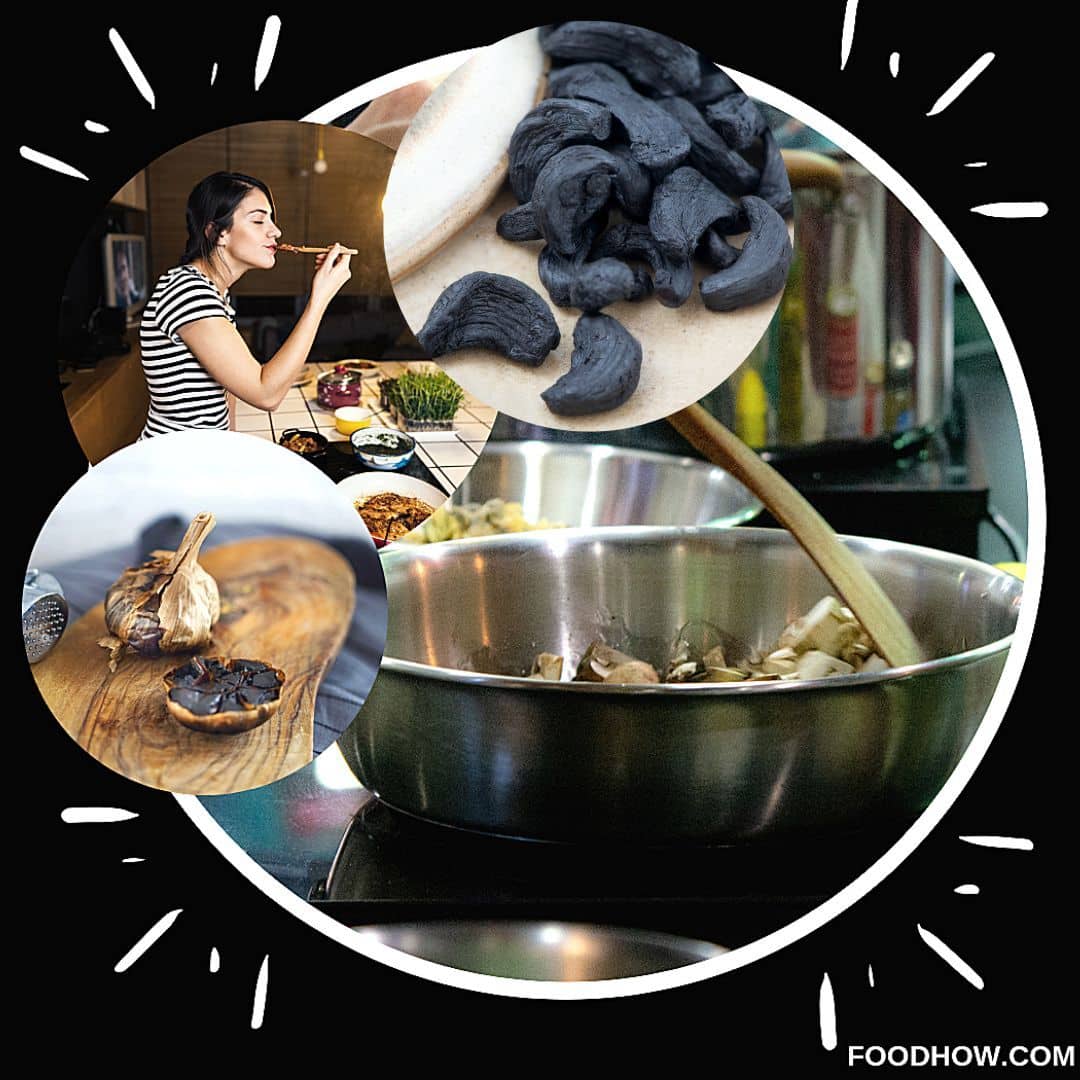
Black garlic is often used in cooking, perfect in savory or sweet recipes.
Arguably, black garlic is just as versatile as regular raw garlic. Go ahead and use it in any dish that calls for roasted garlic.
It’s also great for adding extra oomph to savory dishes, such as soups, stews, and dips. Another great option is pureeing it with a dash of olive oil to make garlic paste, a great base for marinades and sauces.
And for the most daring, there is a dedicated recipe book with 50 black garlic recipes that you might want to check out!
TAP ON IMAGE TO VIEW PRICE
Just like normal garlic, you can find black garlic in powdered form, which is a great quick fix. Look for it on the spice shelf next time you’re shopping for groceries, or you can buy it on Amazon.
TAP ON IMAGE TO VIEW PRICE
Just a tiny sprinkle of black garlic powder instantly infuses any dish with a unique sweetness. From burgers to pasta and casseroles, the possibilities are endless.
There is no limit when it comes to cooking with this tasty ingredient. You will find some easy and delicious recipes incorporating this wonder seasoning here on Pinterest.
Read Also: Easy Tips to Get Rid of Garlic and Onion Breath – Try Now!
Summary
- To make it, one must leave raw garlic in a temperature-controlled environment (120-160°F) for 3-5 weeks to develop a unique flavor and soften it up.
- It is higher in antioxidants and certain micronutrients (iron, for instance) compared to untreated garlic.
- It is known for its potential health benefits.
- It has a very low-calorie content.
- It is a good source of fiber, sodium, iron, and vitamin C.
- In addition to purchasing a ready-made product, you can try making your own using a rice cooker, crockpot, or fermenter; the aging/cooking period is 3-5 weeks.
Have you tried making your own black garlic, and what did you use to make it?
If you have any questions about how to use it or how to make black garlic at home, please also let me know in the comments below.
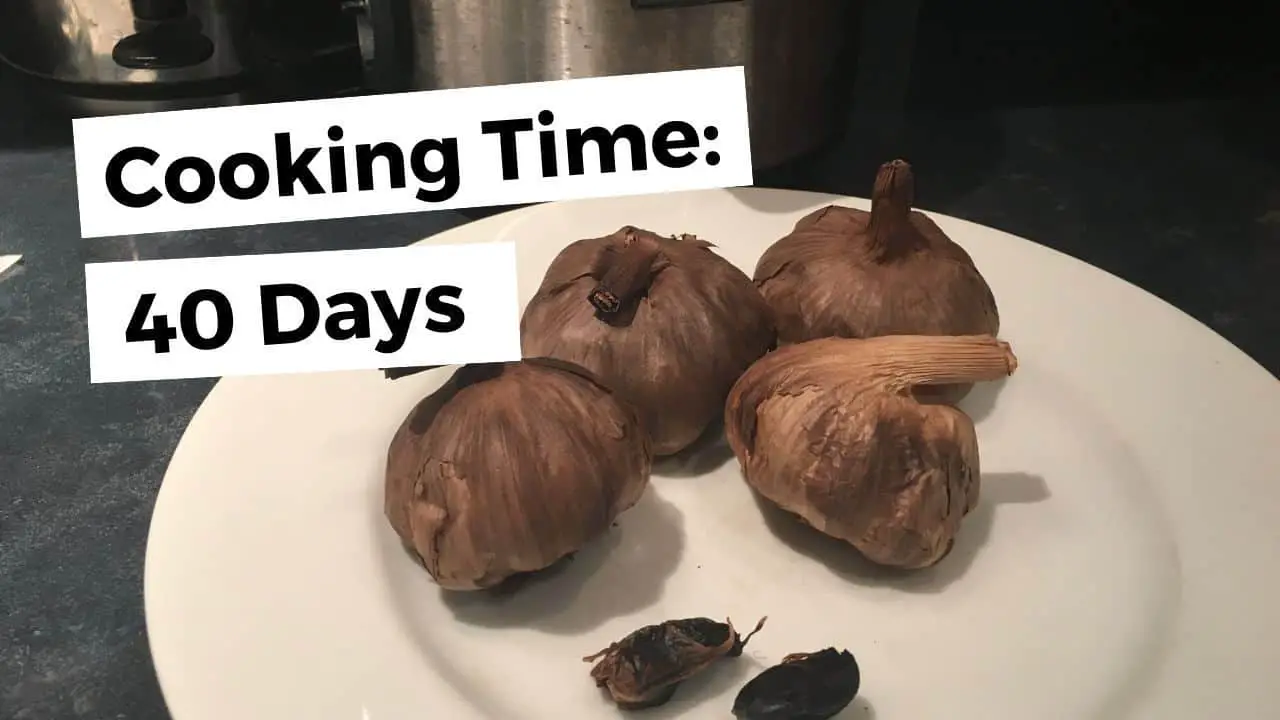


![[New] Magnifique 4-Quart Casserole Manual Slow Cooker with Keep Warm Setting - Perfect Kitchen Small Appliance for Family Dinners - Large Enough to Serve 4+ People [New] Magnifique 4-Quart Casserole Manual Slow Cooker with Keep Warm Setting - Perfect Kitchen Small Appliance for Family Dinners - Large Enough to Serve 4+ People](https://m.media-amazon.com/images/I/414H9mgTG5L._SL500_.jpg)







Fascinating. We’ve got some blood sugar issues in this house, so the anti-diabetic properties are especially appealing. Plus, it’s so hard to find fermented foods that everyone here will eat! I’m definitely going to add some of this to my Amazon wish list and get some the next time I make an order!
It’s not a meal without garlic for me. It is strange that I have never tried or even heard about the fermented version before. I did order some from Amazon, can’t wait to get it already, I am really curious now.
I remember when I didn’t even know what that ugly looking thing was, just saw the pictures and I hated it, but now it’s one of my favourite food additions, it’s always on my table.
Dear Jen, I am a big fan of your work, I already started following you when you were writing for the wellness cooking blog. Please keep up with awesome/phenomenal work and I`ll support you with sharing and talking about you. Many kisses and love to you from Andjela
Very interesting article and useful instructions, Thanks Jen for posting it. Also, could you elaborate how effective is this garlic against vampires? I don’t want to go through the month’s long fermentation and then discover that it’s not working. If you could kindly let us know, better be safe than sorry. Thank You
Oh man, I was JUST looking at a roasted garlic soup recipe today, and wonder if there were more things I could do with whole garlic bulbs. This seems like the PERFECT job for my smaller sized crockpot. I’ve been looking for a way to add more fermented foods in my diet, and this seems right up my alley!
This is a quite interesting post. It is strange that everyone knows about regular garlic because it is such a popular culinary ingredient used across the world. And I think everyone should have it on their spice rack not just for its culinary use, but for its medicinal properties as well. I just love it because it contains enzymes, sulphur compounds and a variety of other nutrients including vitamins, minerals and fibre but it seems that black garlic is even more powerful so I really need to try it out.
Why white raw garlic has such an offensive strong smell but the black one has no smell at all?
The most active compound present in Garlic is allicin, however, allicin is not present in whole garlic. It is produced when it is cut or crushed. It exposes a sulphur compound alliin to alliinase. But black garlic doesn’t have that offensive smell because of the reduced content of allicin.
Wow, I’ve never heard of black garlic. I haven’t seen it in any of the shops, farmers market don’t sell it. There is nowhere I could buy it really, nobody sells it. I want to taste it before I start making it at home myself.
I just started making back garlic myself. btw, it’s not fermenting, it’s aging. I don’t know why I would think fresh garlic is better to make it with, but I did. so I wonder if I make it the right way. I’m a bit afraid of it (because of freshness) need much longer than two weeks in my rice cooker, or that they’re getting molded by the humidity in the cooker. I’m on day 3. shall I watch to see or waste time by continuing for possibly a failed process? can anybody experienced in this process help me out maybe?
I’ve planted half again as much garlic this fall so I can make even more black garlic! I bought some at a local craft fair last year, and loved it so much I found myself a garlic fermenter (Christmas gift to self!) First batch was some organic grocery store garlic, variety unknown–came out much more smoky/savory with just a hint of both sweet and bitter. Had to wait until this year to try my own garlic (last year I’d already pickled or otherwise used what I’d raised). I raise mostly the “Music” variety–that comes out like the best gumdrops you’ve ever tasted, sweet, complex, and chewy!
I found a bread warmer that is 20″ X 16″ and 4″ deep at a thrift store for $10 and it maintained an even 140 deg temp perfectly I used turkey bags and put 3 1lb bags in it with a trivet to take them off the floor and put in my greenhouse for 4-6 weeks….. I also infuse 20 cloves in a pint of vodka to make a medicinal tonic for when the winter sets in and cold season hits. This last xmas I made a batch of the cloves with Himalayan and black salt that I ground in a mortar and pestle (Not a blender) for gifts. I am so hooked My son is a sushi chef and he uses it for all kinds of dishes and the umami flavor is incredible.
Does the garlic get hard before it gets soft or did mine dry up?
Unfortunately, yours have definitely dried up 🙁 Don’t worry, it happens to me too sometimes, and I have been doing it for years.
You mentioned adding a few pieces of paper towel to the bottom of the slow cooker before placing the garlic on top of it. Does that help to collect moisture or prevent burning/ hardening? This is my first time reading of that method and I have a pretty hot slow cooker, even on the warm setting my bulbs are starting to harden at day 6-7. I wonder if placing the paper towels would help.
Hi Persiasblossom. When I first learned about fermenting garlic in the slow cooker, I was advised to use the bamboo mat at the bottom, but since I could not find round one that would fit properly, I started using regular kitchen paper towels. The benefit I see from using paper towels is collecting moisture, prevent burning on the bottom, and not staining the bottom of the bowl.
The drying out so early in the process is probably because your device is slightly too hot. The average crock-pot temperature should be 62 to 74 C (145 to 165 F.) on the warm setting, but some might go hotter, up to 75 F.
Although that temperature should still be fine, I have noticed that I get a lot better results if the temperature stays around 160-165 F.
I also wrap a plastic cling film around my lid, not only to keep the moisture in but also to eliminate the smell, which seems to help. But if your device is too hot, I am afraid that it would just melt.
When using a slow cooker, it takes some time to get the process exactly right. My friend just recently bought the fermenter, and that makes it so much easier. If you are planning to ferment regularly, then this is the way to go for sure.
It also depends on how many layers you put in; if it is just one layer on the bottom, they will more easily dry out. At least 90 percent of them should end up nice and moist. There are always few that would dry out whatever you do.
Oh, where do I even start with garlic? It’s like my secret weapon in the kitchen! Not only does it add an amazing flavor to dishes, but it also has this incredible aroma that just fills the whole room when you cook with it. Plus, garlic has all these health benefits—they say it’s good for your heart, boosts your immune system, and even keeps vampires away! But seriously, I just love how versatile it is. You can use it in so many different recipes, from pasta sauces to marinades to soups. It’s like the ultimate flavor enhancer!